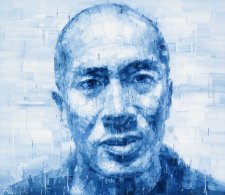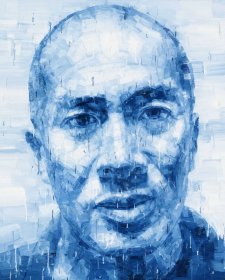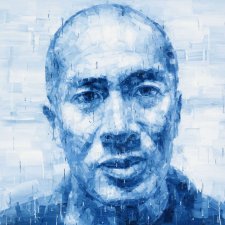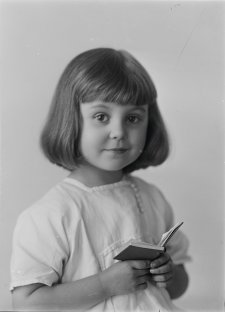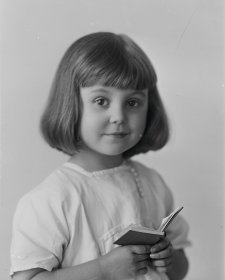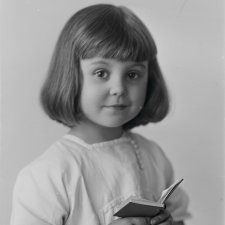Equal parts mischievous and poised, French-born artist and restaurateur Mirka Mora (b. 1928) occupies a special place in Australian art and hearts.
Having narrowly avoided internment in Auschwitz during World War Two, Mora and her husband Georges left Paris to create a new home in Melbourne in 1951. Relishing life in her adopted hometown, Mora’s output has been prolific, with her body of work now spanning six decades and traversing a broad range of media, from painting to soft sculpture to dollmaking. Alongside art-dealer Georges, she also founded a number of iconic café-restaurants that served as meeting places for Melbourne’s preeminent artists, writers and intellectuals. Acknowledged for her formative influence on Melbourne’s cultural identity, Mora is loved as much for her contributions to contemporary art as for her generous and outrageous nature.
The National Portrait Gallery recently acquired several of Lazar Krum’s portraits of Mora and her family, taken in 1966 at her studio/home on Collins Street and beach house at Aspendale. Defined by affection and warmth, the photographs provide an insight into the character of the artist. In Mirka and Phillippe, Mora appears almost sceptical; standing next to her son she regards the lens with twinkling eyes and crossed arms. In Mirka – 9 Collins Street, she poses before a mural of her characteristic softly rounded, angelic figures, her eyes opened wide in playful mimicry of their unblinking gaze. Photographer Krum suggests the image ‘has captured Mirka, in the midst of her iconic faces, caught between both the delightful and ominous nature of her life experience’. In William – Aspendale, Mora’s son William stands in front of one of Mirka’s charcoal drawings, his expression reflecting the unique figures and faces in her work.
As with these works, Mora’s autobiography, Wicked But Virtuous: My Life (2000), is imbued with the artist’s characteristic joie de vivre. The following excerpts, carefully chosen to complement the Gallery’s portraits and a selection of Mora’s works, revel in nostalgia and celebrate the joys of her artistic life. She describes her motivations and methods; friendships and influences, including numerous luminaries of the Australian art world; and, in bittersweet prose, gazes bright-eyed at a mortality which she described as ‘approaching’ at the time of writing in 2000. And yet, Mirka Mora is still with us sixteen years later, her undimmed gusto and creative expression highlighted by a 2016 collaboration with iconic Australian fashion label Gorman.
"Sometimes I think it must be as good to ‘read’ paintings as to make them. It is uncanny how you encounter a book at the right time and it gives you a great push, a revelation that consolidates your work, your thinking. Sunday Reed gave me Lettres complètes d' Abélard et d'Héloise – her mother’s book – Ouevres poétiques by Apollinaire, and The Penguin Book of French Verse. Charles Blackman gave me the Supervielle book, Oublieuse mémoire.""Lovers give you books that you understand later in years, after the affair has ended."
"Being self-taught, my reading is very much like a girouette and sometimes like a compass. And as I go in all directions, I find my own way to enrich my knowledge of art and the making of it, and, with luck, my thinking. All the same, face to face with a new canvas, it is as if you have never held a brush before, and all the knowledge melts, probably into something marvellous, and you are alone with your work which appears slowly, so slowly, but surely."
"Letters and writings from painters are great sources of knowledge and comfort. I think of Matisse on painting, Leonardo da Vinci’s notebooks, Van Gogh’s letters to his brother Theo, the writings on Poussin, Corot, Vermeer. I could write lists and lists of subjects on painters only, that would cover the earth and the sky."
"I also love to spend hours looking at Michael Jaffé’s four volumes of The Devonshire Collection of Italian Drawings, on the Tuscan and Umbrian schools, Venetian and North Italian schools, Bolognese and Emilian schools, Roman and Neapolitan Schools. By looking at all these works, I discover the different materials used and renew my adoration of drawing, which in turn enriches my paintings."
"Many a time I have gone to bed very hungry, but with rare books as good teachers. Far into the night I read all the mysteries that lines hide, contain or give away. Many clues to the next generations of true artists and connoisseurs of art."
"What is intriguing to me about my work is that when I prepare my palette, and I like a very limited amount of colours, I will hear music. High notes for brighter tones or pure colour, and low notes for darker tones or colours – red, brown, black. Got to go back to John Gage’s book, especially Chapter 9, ‘Colour Under Control: The Reign of Newton’. It describes the palette of great artists, to be read as music in my case, or great novels, le secret des couleurs. It is so good to read and see palettes of great masters through the centuries, how colours were thought of, particularly the idea of red, yellow and blue, all explained in the Gage book, along with the origins of the colour circles, which were accidentally devised by physicians when diagnosing disease by uroscopy. But then printers also discovered mixtures of colours by chance."
"All the disciplines are a family to produce the making of art. But it is good to have a grandparent's genes who was a painter in any manner in any century. As you can see, talking about my work makes me go round and round, always ending up alone in front of a canvas or a blank page of best paper with best pens and paints. I think when you don't want to be the prisoner of a formula, at each painting you start you have to reinvent the art of painting - it takes more time, and the interest you find in searching gives life to your work. And it shows, for colours are made by our feelings, our optic nerves, our observations of nature that we have to rob, to steal from. Even though nature is offering all her secrets, we still have to decipher it, concoct it as best we can and sometimes reinvent, as her lighting is often treacherous: a sudden violent wind turns all the leaves of the trees from light to dark, and vice versa; the rough sea could blind you with its white foam as it roars."
"On very good days, when I am not writing and have no interruptions, I will find myself at my easel not remembering having left my bed. I will work until 3.30pm, stop, have a coffee, a shower, and go out and have lunch, often at Cicciolina in Acland Street. The lunch is really my breakfast, lunch and dinner in one go. Sometimes I love to go to Becca in town, it is close to my son William’s gallery. Then I will go back and look at my work, often in total wonder as I know a painting takes in my case many months to achieve. If it is a very good painting, I will hide it so I can look at it for a long time, as I could never afford to buy it – a bit like a dog who hides its bone. Then I have to study my treasured books to find out more about painting. If there is a great show of masters at the National Gallery of Victoria, I will go and lose myself in the rhythm of the brushstrokes and get too excited about the way of the applied colours, go home like a drunken sailor – dangerous."
"But it is most important to see good work as I still have to learn so much. In the fifties and sixties, I was surrounded by beautiful painters and their work. I was learning fast, but slow in digesting my learning. John Perceval’s flamboyance, Charles Blackman’s poetry, Arthur Boyd’s naturalness come to mind. Joy Hester’s passions, Nolan’s magic, Fred Williams crystallising his art. I loved Fred Williams coming to my studio at 9 Collins Street with a little bottle of drawing ink in his pocket and pen and nibs, and drawing my children, my cat Napoleon, and myself brushing my hair. His line was impeccable and I learned about the true art of observing, drawing, seeing and simplicity."
"Arthur Boyd was very generous with his paints: he ground them himself and would often bring large tubes to me and to Charles. Once we all got nursery blue and what a blue it was – dreamy. Arthur also sharpened bamboos into fine quills for me to draw with when he noticed my acharnement – relentlessness – at drawing. Two other painters I loved watching were John Howley and Don Laycock. I learned about tonal value from them as well as rebellion, colourwise. At John and Sunday Reed’s home I would have learned much without knowing as the house was full of paintings and I drank them with my eyes and brain, which of course is good schooling for a selftaught artist, to be surrounded by so many artworks."
"Though I love abstract art and get enormous pleasure out of it, I tend to be a maker of images, my eternal images. Eternal because they are so simple – children together, often holding or surrounded by birds or dogs, a sky, a tree, a fence, the faint suggestion of a faraway landscape. Little hills are coming, as I see them at The Four Winds open-air concert every year in Bermagui. I dribble looking at the perfect landscape behind the musicians’ stage, and a transparent wall separates them from the little hills and trees and a little lake. The music and landscape is enough gearing for one year or more of paintings. Slowly I will have more courage to go into landscape, even if the price is high for me. "
"One year, as I was listening to the ensemble Gombert and Fonte play Bach’s three motets for double choir, I happened to lift my head and look at the sky, and I realised that I would leave the sky as well as the earth when I die, and I cried miserably. Maybe, when we die, we turn into music if we listen to it carefully when we are alive. I must say the immensity of the sky over Bermagui was so grand that all my emotions got very confused and I was glad for it. It is good to be confused – you can choose your miseries then, and afterwards."
"I have never listened to reason and have had a bumpy ride, and survived, desperately looking for wisdom as reason is incomprehensible to me. It is too abstract, too complicated; the logic of reason baffles me and maybe there isn’t any. All the same, I have always protected my work, my free spirit, and remain independent and poor in my old age, ready to tackle death my way. How? I am thinking about it and it better be good, maybe a big party and filmed while I say goodbye and thank you. I have a beautiful enormous book written by Michel Vovelle in 1983. Its title: La Mort et l'occident de 1300 à nos jours. I think I will have fun rereading it and prepare myself with style."
"Nouzette told me once about paradise, purgatory and hell, and the devil with his fork waiting to catch you. For a long time in Paris as a child, I imagined the devil and his fork at the door of lifts and I was petrified, thinking the lift would descend right down to hell. By the age of ten, I thought more of purgatory, and had many nightmares about it as I saw Dante's Inferno painted by Botticelli, which my father had introduced me to. As I grew up slightly my thoughts leant towards paradise with many angels everywhere. Now that the time of death approaches, I roam through the universe as a little bit of dust looking to plant myself in a star and grow again one day somewhere. Lady Casey once told me that dust is nourishing. There lies a mystery, unfathomable."
Excerpts reproduced with the permission of Penguin Random House Australia.




